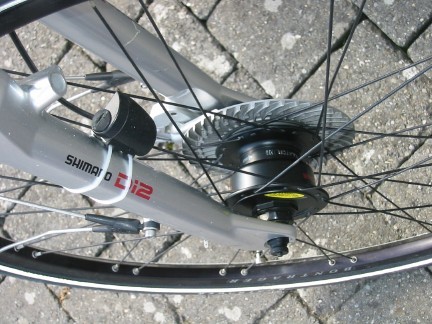
Smooth Mover!
My Trek Navigator L700 "Smover"
Bicycle with Automatic Gearchange and Electronic Adaptive Suspension
delivered by Shimano Di2 Cyber Nexus Groupset
a photo essay by André Jute
Some journeys made on this bike are illustrated here.
This page contains the Shimano Di2 Cyber Nexus techie porn for hard core city and touring bike fans.
The people who stop me daily to admire my Trek Navigator L700 don't even know that it is officially a "Smooth Mover", elided by Shimano-speak insiders as "Smover". Mostly they don't care that my bicycle has an automatic gearbox and adaptive suspension just like their Range Rovers (though the suspension works in reverse to that of the RR). They just want to enjoy looking at an impressive bicycle. So let's look at a few of the more general details before we get into the technowhizbang bits. Even the more conservative elements of this bike are astounding.
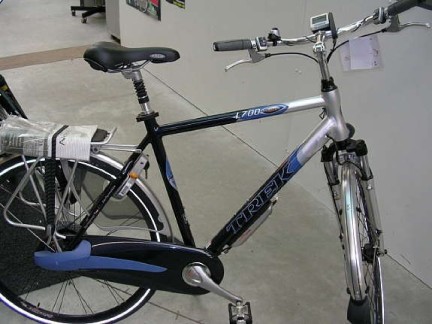
My Trek Navigator L700 "Smover" as bought, here seen standing at the shop in Belgium from which I bought it. A certain amount of light re-engineering was required to make the bike fit me, particularly to the electronic cabling which had been designed short for a sleek, sporting, more Trek-like appearance. Fortunately, after the dealer didn't even reply to my letter, Trek Benelux enthusiastically helped me make the bike work the way I want it to work and to fit me like a glove. I cannot tell you how impressed I am with Trek's service and in particular with their helpful, cheerful attitude.

This is what I turned the bike above into. The handlebars are now at a proper elevation above the seat for a city and country bike, even one with sporting pretensions. That eunuch-maker saddle shown in the previous photograph was instantly thrown off in favour of a Cheeko90, against which I just lean, rather than sit on it; much more natural.

The Bontrager Satellite Elite wheelset was originally developed for this bicycle. They are absolutely superbly designed and made wheels, very beautiful. Also in this photograph, the frame-fit lock, the stand, the rear roller brake, the stylish coat-protectors, the ali carrier with side-frames for panniers, the SKS minipump fitted to the carrier, the excellent Spanninga Ultra automatic rear battery light with built-in light and motion sensors, all standard equipment. The racktop bag is a Trek too, which I bought for use on my previous town and country bike, a Gazelle Toulouse, and liked well enough to bring forward to my new bike. The Cateye TL-LD1100 attached to the bag is just bright enough when the batteries don't have too many hours on them to be used in bright sunshine as an eyecatcher for drivers of cars and trucks.

The wheels include some thoughtful details that I have never seen elsewhere, presumably because Trek patents Keith Bontrager's ideas to reserve them for themselves.

The matching Satellite Elite Hard Case tires are equally pleasing. They are almost slick and are intended to be used in a very hard state (55-85psi) so that the contact patch is tiny and the rolling resistance very low. I don't imagine they would work too comfortably on an unsuspended bike but on the Smover they work brilliantly. They are also puncture proof, as advertised. After 1100Km mine show no signs of wear; they appear to be a good alternative to another puncture-proof tire of which I have excellent experience, Schwalbe's Marathon Plus.

The front wheel with its roller brake, the electronic Shimano Di2 (Digital Integrated Intelligence) adaptive front suspension and, under the downtube, the central computing and energy storage unit which instructs all the components how to behave. The empty bottle holder is to hold the battery for my touring lights. The Spanninga Radius halogen light attached to the front fork is standard but, at only 2.4W and driven by the hub dynamo rather than batteries, suitable only for use on lit streets; it has a decent spread and reach of light once you are going even slowly but zero light when you stop. The Radius light has no switch; it is switched through the bike's electronics, and can be on permanently, switched on manually via the Flight Deck when desired, or switched on automatically when the light is low and the bike is moving.
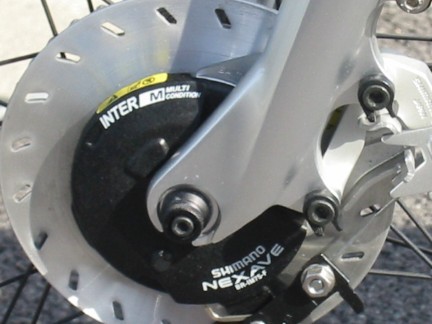
The front roller brake and its massive cooling disc. There is no doubt in my mind that it is quite as powerful as a disc brake. Shimano claims these roller brakes are more controllable than a disc brake but the most powerful of their roller brakes, the BR-IM75 as fitted on my Smover will certainly send you over the handlebars onto your helmet if you squeeze the lever carelessly at 40kph on a steep downhill; they are very powerful brakes. Trek delivered the bike with a very nice quick release skewer in the front wheel; I straightaway replaced it with a keyed skewer — of course such attractive wheels will be magnets to thieves!

Rear roller brake.
Both the front and rear brake cooling discs are of cast aluminium, slotted and heavily finned for heat dispersal. Disc brakes are supposed to run cooler than roller brakes but I haven't noticed these roller brakes become hot at all. It seems to me that the arrival of the BR-IM70 and -75 is the point where roller brakes attain their majority. These certainly match disc brakes stop for stop. The black part of the hub is the dynamo. It supplies power not only for the front light but for the computers, gearchange and adaptive suspension. The legs of the adaptive suspension, seen above, are magnesium to save weight.
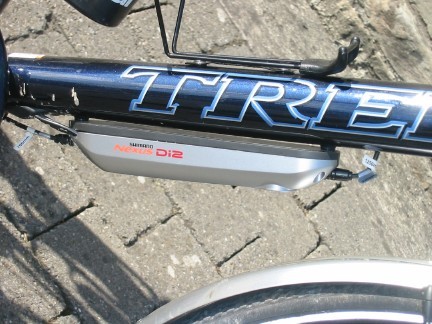
From the dynohub the electricity comes to the heart of Shimano's Di2 Cyber Nexus "Smover" system, the central processing and energy storage unit. That's the flattened pod sitting under the downtube. On its underside is an aperture for measuring the intensity of ambient light so that it can decide whether to switch on the lights. On my Trek Navigator L700 "Smover" only the front light is driven by the dynohub, the rear being battery-operated with its own built-in light and motion sensor; however, the CPU will switch on and off both lights if both are wired into it.
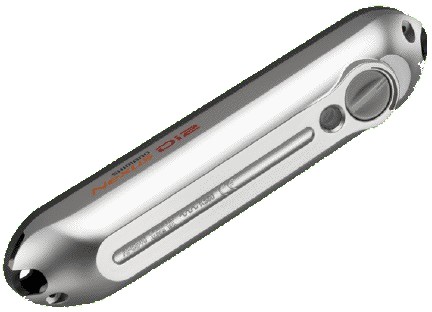
Also on the downward face of the CPU is an eight-level desired pedalling effort selector. This is akin to an athlete and his coach deciding on a suitable cadence for him and choosing the mechanics of his bike to match the cadence. The pedalling effort selector determines how quickly the gearbox shifts up and down in the automatic modes (several, controlled from nearer your thumb—we'll come to them). From the CPU cables run to the motor unit on the rear hub, the Flight Deck on the handlebars which is your control centre, and the light(s). A cable from the Flight Deck carries instructions to the adaptive suspension unit. Everything is powered by the dynohub.
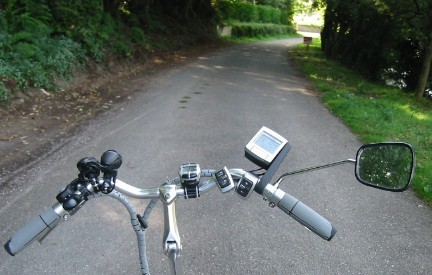
The office. The black touring lights and the heart rate monitor/bike/skiing computer in the centre of the handlebars, as well as the mirror, don't come with the bike; the bell, not visible, is mounted between the lights and their switches so that its lever falls directly under the left forefinger. This entire setup is arranged for ergonomics rather than appearance: everything required to be operated on the move falls under a finger without removing the rest of the hand from the grips. (Though the grips appear split, they are not; they operate nothing.) The Flight Deck command centre, mounted next to the base of the mirror, and the two switches below it control the gears and the suspension.
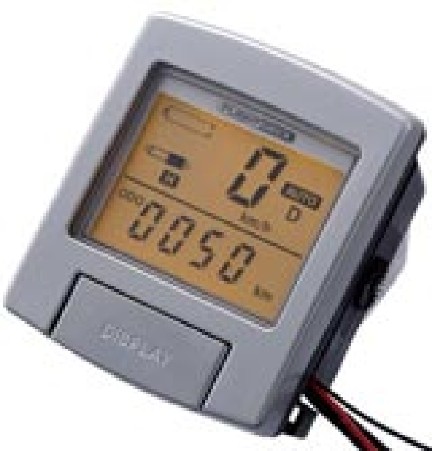
The Flight Deck tells speed and time and distance and so on on its backlit LCD face just like any simple bicycle computer. But is also the rider's control centre for the CPU. Besides initial setups like rolling radius of the wheel and tyre combination, the Flight Deck is also used as a readout for the gearbox and the suspension, and to record the operations of the two switches below it. In this photograph the Flight Deck reports top left that the battery is not charged, below that the blank space indicates that the suspension is in manual mode (in auto mode the word "AUTO" appears), below that the suspension is currently set to soft, at the bottom that the bike has ridden a cumulative total of 50Km since last reset (there is also a trip meter for measuring daily rides); moving over to the right hand side, we see that the bike is standing still (zero Km/h) and that the drive range "D" is selected. The button at the bottom selects actual gear used, time, trip meter, cumulative distance, and is also used in conjunction with the other connected switches for switching the lights on and off and selecting the presets.

Having set pedalling effort on the CPU, the rider is now offered four riding modes. Manual geachanges are effected by pressing the plus and minus switches on the thumbswitch for up and down changes. Pressing the shiny button between them gives successively D, Ds and L drive ranges. D is the normal setting, much like Drive on an automobile. Ds is a sporting version which locks out first gear and shifts into higher gears at lower speeds: faster but more tiring. L is called "Leisure" by Shimano but is a little old lady range in which the computer hangs on to the lower gears for what seems forever to make pedalling very easy indeed; if you need this range except on absolutely vertical ascents, you have the pedalling effort selector on the CPU set too high. Whether in manual or auto, the drive mode and the currently operative gear are reported on the Flight Deck. When you slow down, the gearbox changes down of course, and when you stop it changes all the way down to the lowest gear permitted by the selected range (second for Ds, first for D and L) so that you are always in the optimum gear. As a result of the more optimal pedalling regime automatically arranged for you by the computer, you will probably cut about ten per cent from the previous times for your regular rides; I certainly did
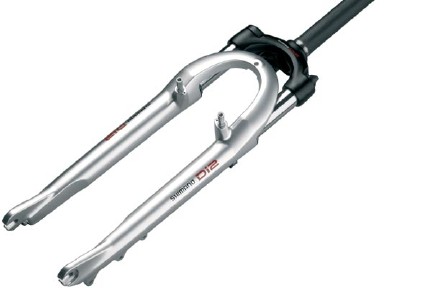
The other switch changes the suspension setting (front and rear if both are fitted -- my Smover has only the front suspension) in the manual mode from hard to soft by the eponymous switches, and from manual to auto and back by pressing the shiny switch between them. In auto mode the suspensions adapts to riding mode and road inclination. When you're starting off the suspension will be hard. Ride faster and it changes to soft. Slow down or ascend a hill and it changes back to hard. Speed up and it switches to soft. The purpose is to stop the suspension soaking up pedalling effort when it is neeeded for acceleration or ascending a hill. The selected mode and current operation condition of the suspension is reported on the Flight Deck.

Shimano Di2 Cyber Nexus 8-speed internal gear hub. There are no external derailleurs on this bike; with the fully-enclosed chaincase removed it would appear to be a single-speed bike. All the gear chances happen internally. But the gearbox is just that, a box full of gears. Though it is prominently labelled Di2, it is effectively the familiar, proven Nexus Premium 8-speed manual box adapted for electronic shifting by an external motor.

The gearchange is performed by a surprisingly small motor unit. It is the charcoal-gray box just visible past the bottoms of the carrier and mudguard stays behind the chaincase. Instructions arrive here from the CPU and are executed much more smoothly than one can do it manually with a rotary control. (I also own a manual Nexus 8-speed bike.)
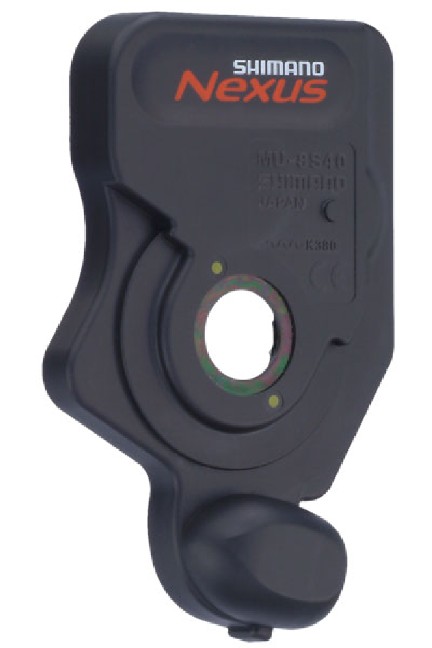
The whole of the tiny motor unit that changes the gears. The bump right at the bottom is where the control cable from the CPU plugs in.

This is the other place where final instructions arrive: the top of the adaptive Shimano Di2 front suspension unit. You're looking down past the heatset at the wheel turned at right angles to the frame. The curve of black cable belongs to the hub dynamo. The suspension cable is hidden by its own label but you can see the black DIN flying socket inserted into the top of the suspension, just about dead centre of the photograph.
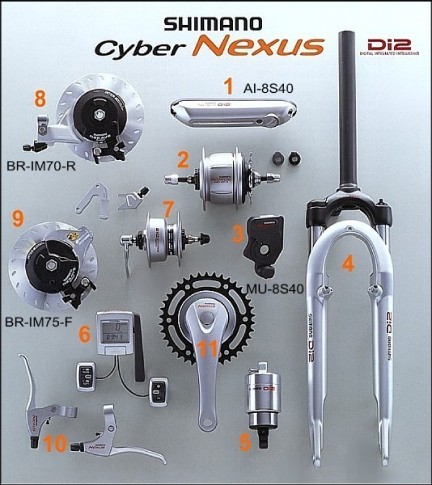
This is the entire Shimano Di2 Cyber Nexus Groupset, less only the electronic cables. All the units have already been identified. No 5, the rear suspension unit, is not fitted to my bike. The two small round items near the internal gear hub are anti-rotation and alignment axle fittings whose prongs slide into the dropouts. There is also a buzzer built into the Flight Deck to tell of gear and suspension mode changes, failures and errors; you can switch off the buzzer but then you will have no way of telling when the gear changes if you are viewing any Flight Deck screen but the gearchange screen, because there is no clunk or other indication that the gear has changed. In this sense Shimano's Di2 Cyber Nexus internal hub gearbox is a bit too good for its own good. Of course, many will argue that the purpose of an automatic gearbox is set-and-forget; that knowing in which gear you are is obsolete derailleur-think; they are probably right, because the Cyber Nexus is always automatically in the right gear for me. I just find it hard to break the habit of wishing to know which gear I am in.

With any sophisticated high-tech gear a valid question is always: will the components be as durable and serviceable as the simpler versions? In this case the comparison must be with the manual Nexus Premium internal hub and associated components. I see no reason why the mechanical and fully enclosed electronic parts (that's everything except the cables) shouldn't last as long as the known-good manual Nexus Premium and Nexave and Ultegra components they derive from. The electronic wires, here seen under the bottom bracket shell, appear to be the only vulnerable part of the Di2 system, easily damaged by careless handling (those plugs are keyed and have yellow dots over the keys for a reason!); they are also in several places exposed to freak accidents even in normal use; it would be foolish to take this bike into the brush and the rocks and treat it like a crosscountry bike just because it is descended from mountain bikes and shares their unbreakable frame. But I obtained longer cables on request to Trek Benelux, so spares are available, and anyway the cables use common subminiature DIN plugs, available from any electronics catalogue, so cables could easily be made even if Shimano eventually orphanes the Di2 series. In short, I see no reason why my Smover should not be handed on to my grandchildren just like any other top-quality Dutch stadfiets from Gazelle or Koga-Miyata.

Wiring inside the Flight Deck. Shimano apparently intends manufacturers to cut the cables and crimp on new connectors, so as to achieve sleek lines for their bikes. That also means limited adjustability, as happened to my bike. What the devil were they thinking of at Shimano? Did someone forget to tell the engineers the Di2 system was destined for comfort bikes?
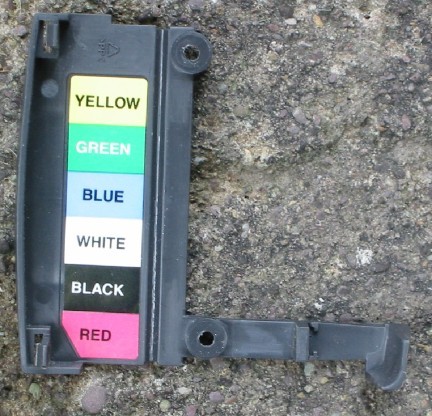
Shimano even provides a colour code in the most convenient place, where you can't miss it, right inside the cover of the Flight Deck. It appears that they agree with me that the cables should be owner-serviceable, replaceable and rebuildable. These photographs were taken as mnemonics for reassembly when I had to take the entire system apart to feed longer electronic control cables through the bicycle frame. Paul Lange, Shimano's excellent distributor, keeps a huge archive of service sheets in several languages which the owner of a Shimano-equipped bike is well advised to surf and download.
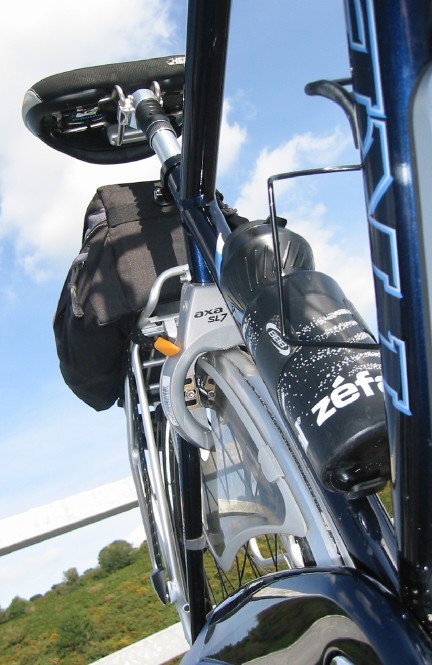
Another view of the seat of power. The Axa lock is permanently attached to the bike frame; you cannot remove it without destroying the bike. It is also electronically chipped to aid tracing if stolen. To operate the lock, one pushes down on the orange lever on this side of the bike while removing the key from the other side of the bike. Merely removing the Flight Deck from its holder doesn't immobilize the bike though it cripples it to the gear range and suspension mode set when it is removed.

It's a fabulous ride, my brothers and sisters. You just get on your bike, pedal and watch the world go by. I ride further than I did, and more often. There's another major benefit: of the Smover system: the automatic adjustment of the gears to my preferred exertion level has also put a far greater portion of every ride into my preferred heart rate zone, which is for building endurance rather than sprinting; automatic gears are keeping me in the aerobic range about twenty per cent longer than before! I feel so much better for all these cumulative effects that I enhance the "Smover outcome" by adjusting my roadspeed to my maximum aerobic respiration rate; that is why the heart rate monitor is so prominently in my sightline. That is, I choose my own parameter of performance and the bike adapts to it. Those with engineering inclinations may view this as a feedback effect. It is the perfect obverse of the perversity that the rest of cycling has become: I don't contort my body and my behaviour to the bike: instead the bike adapts to me. Damn right too! Technology should be the servant of man, not the other way round.
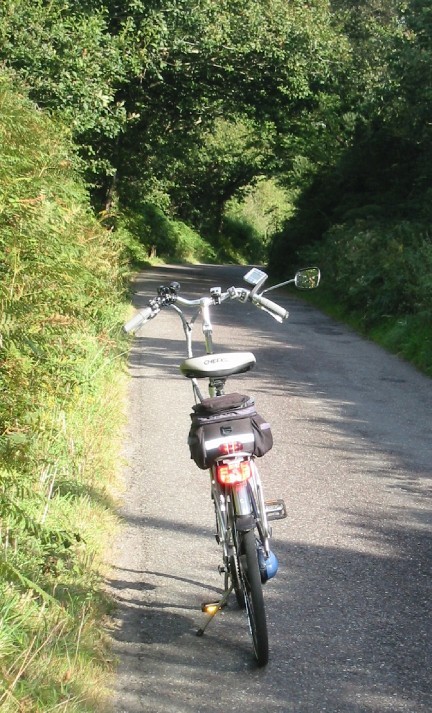
I know the Trek Navigator L700 "Smover" is a Dutch stadsportief, that is, a town and country bike or more mundanely a city-sports, but it seems a shame to shackle such a bike even partially to commuting, no matter that it would clearly perform that function in the same superior manner it tours the open road. Those pedals are the silky-smooth VP-191; Trek Benelux made me a gift of a pair (and some other service parts and materials too) to make up for the irritation of having to ask them for longer cables for my bike after the dealer failed me. It is the small things together, as much as the big things like the right geometry and a trustworthy frame, that makes the difference between mere transport and a Great Bike.

The Trek Navigator L700 "Smover" is a genuine sleeper of a Great Bike.
•André Jute’s most recent book on aesthetics in action is
Grids: the structure of graphic design (Rotovision, Switzerland).
All text and illustration Copyright © Andre Jute.
Some component photographs appear by courtesy of Shimano


























